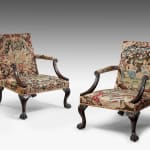The Gibside Gainsborough Chairs
The needlework covers: FRANCE, circa 1730-50
98 x 75 x 58.5 cm
Further images
-
(View a larger image of thumbnail 1
)

-
(View a larger image of thumbnail 2
)

-
(View a larger image of thumbnail 3
)

-
(View a larger image of thumbnail 4
)

-
(View a larger image of thumbnail 5
)

-
(View a larger image of thumbnail 6
)

-
(View a larger image of thumbnail 7
)

-
(View a larger image of thumbnail 8
)

-
(View a larger image of thumbnail 9
)

-
(View a larger image of thumbnail 10
)

-
(View a larger image of thumbnail 11
)

Provenance
Bowes Family, Gibside, County Durham. Private Collection, USA.Both chairs with needlework upholstered padded back and seat, the arm rests with acanthus carved supports, raised on cabriole legs carved at the knees with acanthus leaves and bellflowers, terminating in a hairy paw foot. Both chairs stamped Gibside.
The front rail of one chair replaced circa 1900-20, the needlework restored.
Gibside came into the possession of the Bowes family in 1713, with the marriage of Elizabeth Blakiston, the only daughter of Sir Francis Blakiston, 2nd Bt., to Sir William Bowes of Streatlam Castle. In 1721, Sir William’s son, the coal baron George Bowes, inherited, and set about establishing one of the most important houses in the north of England. The house now lies derelict, but Bowes’ magnificent Palladian chapel survives and is regarded as an architectural masterpiece.
In 1743 George married heiress Mary Gilbert and over the next two decades, numerous purchases were made from London’s most fashionable dealers and cabinetmakers to transform Gibside into a venue for entertaining, and for displaying the family’s new prosperity. In 1756, Mary Bowes made a purchase of furnishings from the leading furniture maker John Cobb, who with his partner, William Vile, supplied pieces for many of 18th Century England’s stately homes. One of Lady Bowes’ purchases, a large Rococo mahogany clothespress similarly stamped Gibside, is now in the collection of the Metropolitan Museum of Art, New York. Their daughter, Mary Eleanor, married John Lyon (later Bowes), 9th Earl of Strathmore.
The carved ornament reflects the height of 1740s fashion and is seen on a number of published chairs from the George II period. The Gibside chairs are remarkable in their demonstration of the chair makers’ art; the poise achieved by the perfect balance of the four cabriole legs demonstrating the extraordinary sculptural quality achieved by the London craftsmen of the time.











